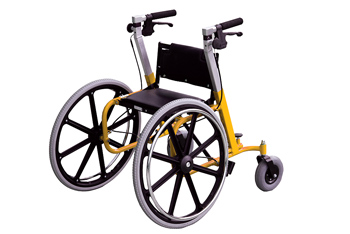The Father of Invention Made in Montana: Walk’n’Chair™
 If necessity is the mother of invention, inspiration is certainly the father. Lloyd Lautzenhiser, one of the inventors of the Walk’n’Chairâ„¢, was originally inspired by the needs of his grandfather, a farmer, who needed a mobility solution that would work in unconventional terrain, such as a field or meadow.
If necessity is the mother of invention, inspiration is certainly the father. Lloyd Lautzenhiser, one of the inventors of the Walk’n’Chairâ„¢, was originally inspired by the needs of his grandfather, a farmer, who needed a mobility solution that would work in unconventional terrain, such as a field or meadow.
More recently, he saw the need of his brother, who wanted to be able to navigate areas not conducive to a traditional wheelchair.
The meeting of necessity and inspiration came together to create the Walk’n’Chairâ„¢, a solution for a niche market who wanted mobility over a variety of terrains in order to maintain their active lifestyle. It’s a convertible walker and wheeled chair that is durable and engineered for stability and portability.
Built primarily as a walking aid, the Walk’n’Chairâ„¢’s stable design means the person using it doesn’t have to focus on the wheels but is able to enjoy the scenery and the walk, much as they did when unaided. Everything from the reversible handles, lightweight frame and accessories are made to enhance the functionality. It offers accessibility not available with a conventional walker or wheelchair.
Using a traditional wheelchair as a walker can be dangerous, Lautzenhiser cautions in the video on the website. “The geometry’s all wrong. Any rehab place can tell you that people get hurt every year by trying that.”
The Walk’n’Chairâ„¢ was designed to be versatile and be configured to meet specific needs.
But it’s not for everyone. Mobility devices are a growing market, and new inventions such as this fit in a specialized corner of the market. “For the people that this does work for, it dramatically improves their life,” Lautzenhiser says.
Comments from users have been overwhelmingly positive and mention the limitless possibilities they’ve discovered, the stability, adaptability and the empowerment the Walk’n’Chairâ„¢ provides.
The demand for the product could accelerate as the word spreads, but that is a mixed blessing for the Belgrade-based manufacturing company, Brookfield Hunter Incorporated.
“We have pre-production models which were made in Bozeman,” says Nick Savko, President. “But we’re struggling to find fabricators for the components and product on a large scale.”
The quality standards are high and the components need to be top-notch, yet the price of the Walk’n’Chairâ„¢ is something that must be within reach of the consumer.
“This product is not covered by insurance or Medicare,” Savko says, even though the company tried to get their approval without success. “So we are working to find private sources to offer financing options to the consumer.”
As they work to solve the problem of production, being able to get the pre-production models into the hands of test markets has been invaluable.
“When we get the product in front of consumers and see how they use it, it’s amazing,” Savko says. Despite the frustrations of manufacturing, what keeps him going is the knowledge that the device has proven to change people’s lives, giving them back some of the independence they crave. He’s talked to people whose lives have been transformed by the Walk’n’Chairâ„¢.
“This walking device seems like a simple invention,” Savko says, “but it solves a very complicated problem for some people.”
The desire to make a difference for people is the foundation of the company.
Lautzenhiser echoes the sentiment in his video, encouraging Walk’n’Chairâ„¢ consumers to share their experiences and their suggestions.
“I have invented a lot of things in my life – I have 30-40 patents,” he says, “and whenever I come up with a patent, somebody will come up with a use for that patent that was not in my idea when I came up with the invention to begin with.”
With the continued collaboration of necessity and inspiration, it’s clear the Walk’n’Chairâ„¢ will impact lives with positive results. And Lautzenhiser’s not resting on his achievements.
“Hopefully the people who use the Walk’n’Chairâ„¢ will send me some more ideas and help me improve other people’s lives,” Lautzenhiser says. “They would appreciate it and so would I.”
Lynn Kinnaman is a regular contributor to Bozeman magazine.